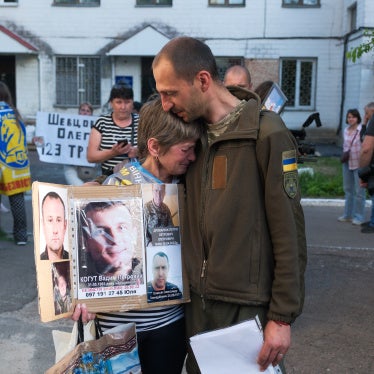We, the undersigned non-governmental organizations, are deeply concerned about the reported changes to the United States’ policy on the use of lethal force overseas, including through armed drones. According to news reports, in October 2017, President Donald Trump authorized changes to the existing policy related to the use of force in counter-terrorism operations in locations the U.S. government describes as outside “areas of active hostilities.”
The Trump administration’s failure thus far to release and explain the changes it has made to a previously public policy
We are deeply concerned that the reported new policy, combined with this administration’s reported dramatic increase in lethal operations in Yemen and Somalia, will lead to an increase in unlawful killings and in civilian casualties. As many of the undersigned groups wrote to National Security Advisor H.R. McMaster in June 2017, the United States should be strengthening, rather than weakening, the previous administration’s policies governing the use of force.
Concerns About the Reported Lethal Force Policy Changes:
Unlawful targeting outside of armed conflict
The undisclosed policy reportedly allows lethal targeting much more broadly than international law permits. Under international law, intentional lethal force may only be used outside of armed conflict when strictly necessary to prevent an imminent threat to life. Within the exceptional situation of an armed conflict, the United States may only target members of an enemy’s armed forces, military objectives, or civilians directly participating in hostilities.
● Elimination of imminent threat requirement:
We are concerned that the new policy reportedly eliminates the requirement that a targeted individual pose an imminent threat. Our concern stems from the need to ensure that U.S. policy allows lethal targeting only where permitted by law. For fighting with a non-state armed group to be classified as an armed conflict, the fighting must reach a requisite level of intensity and the armed group must be sufficiently organized to constitute a party to an armed conflict by, for example, operating under a command structure with the capacity to engage in sustained military operations. Yet the new policy as reported purports to allow permissive wartime targeting to be used outside of situations of armed conflict. If there is no armed conflict, international human rights law exclusively governs the use of lethal force and requires an imminent threat to life before lethal force may be used. Eliminating this requirement, outside of an armed conflict situation, would mean authorizing unlawful killing.
● Incorrect classification of enemy fighters:
The above concern is compounded by the United States’ overbroad definition of who can be targeted under wartime rules. In an armed conflict, only individuals who are members of an enemy’s armed forces or who are directly participating in hostilities may be targeted. But the U.S. defines “membership” in an organized armed group far more broadly, putting individuals at risk of being targeted based on guilt by association, for example because of a house they slept in or a route they traveled.
● Relaxation of standard requiring “near certainty” that the target is present:
We are also concerned about reports that the new policy relaxes the “near certainty” standard that the target is present at the time of the strike to a mere “reasonable certainty.” Weakening this standard increases the risk to civilians and bystanders who may be killed incidentally in strikes where the intended target may not even be present. Relatedly, the prior policy also required “near certainty” that the target be correctly identified before a strike took place. It is unclear if this requirement, aimed at preventing strikes against misidentified individuals, remains in place.
The new policy reportedly preserves the existing requirement of “near certainty” that no civilians are present before a lethal strike is allowed. This is an important safeguard that will unfortunately be undermined if the new policy allows targeting of individuals that are improperly classified as combatants or if lethal force is used outside of armed conflict absent an imminent threat to life.
Lack of clarity around the capture requirement
It is unclear if the new policy retains the requirement that the government capture individuals whenever feasible, rather than using lethal force. Outside of armed conflict, such a policy is required by international law. Lethal force is prohibited in a number of different circumstances even in situations of armed conflict. Eliminating the requirement to capture individuals when feasible when operating outside areas of active hostilities puts more civilians at risk and increases the likelihood of lethal force being used in violation of human rights law.
Expanded role of the CIA
News reports also indicate that the Trump administration is giving the CIA an expanded role in carrying out drone strikes with less review from the White House.
Concerns about increase in civilian casualties and inadequate accountability
These concerns about U.S. policy are heightened by recent changes in U.S. practice. In the first year of the Trump administration, there has been a dramatic increase in U.S. lethal operations in Yemen and Somalia, including a number of concerning incidents involving credible allegations of civilian casualties. At the same time, civilian casualties caused by U.S. and coalition operations in Iraq and Syria have reportedly increased. In many of these cases, we are unaware of any comprehensive investigation, remedy, or condolence payments for victims of violations and their families. These trends and incidents heighten our concerns about the U.S. loosening its policy rules on the use of force.
Recommendations:
1. U.S. policy should apply the law of armed conflict, as it pertains to lethal targeting, only to the conduct of hostilities in situations reaching the threshold for armed conflict under international law, and should ensure that it respects international human rights law at all times. Any use of intentional lethal force outside situations of armed conflict must be limited to circumstances where it is strictly unavoidable to protect against an imminent threat to life.
2. The U.S. government should disclose its policies governing the use of lethal force, including armed drones, the legal framework that it applies to its operations in each country, and all legal memoranda setting forth the basis for particular strikes. It should not make changes in secret to policies that were previously public. The U.S. military should also build on its past practice of making information public about strikes it has taken and any civilian casualties that resulted. All other government agencies involved in using lethal force should be required to do the same.
3. The U.S. government should undertake full and effective post-strike investigations and provide redress for civilian harm and unlawful killings. Wherever there are credible allegations of civilian casualties or unlawful killings, investigations should be prompt, thorough, effective, independent, impartial, and transparent. Investigations should include site visits, interviews with witnesses and victims on the ground, and consultation with NGOs. The government should disclose publicly the results of investigations and any redress for civilian harm provided, subject only to redactions strictly necessary for legitimate reasons of national security or the personal safety of specific individuals.
4. Other states should withhold support for any U.S. operation they consider to be unlawful, for example because the United States applies lower legal and policy standards than required by international law or regional human rights instruments. Other states should also disclose any policies and agreements with the U.S. government regarding the United States’ use of extraterritorial lethal force, including the extent of assistance provided to these operations and any safeguards in place to ensure such cooperation is lawful.
Signed,
American Civil Liberties Union
Amnesty International
Center for Civilians in Conflict
Center for Constitutional Rights
Coalition for Peace Action
Friends Committee on National Legislation
Human Rights Clinic – Columbia Law School
Human Rights First
Human Rights Watch
Interfaith Network on Drone Warfare
National Religious Campaign Against Torture
Open Society Foundations
Reprieve





